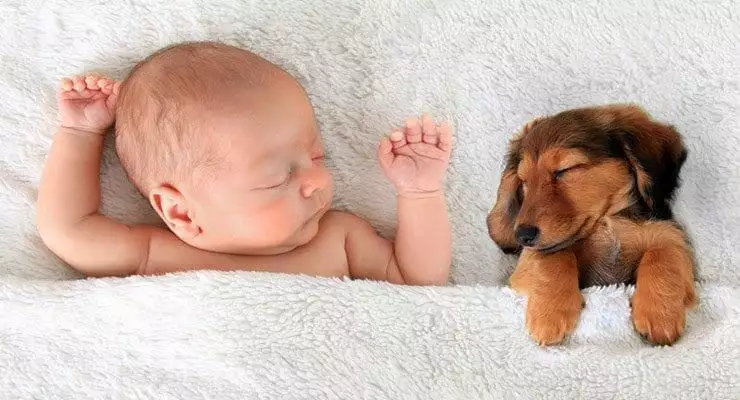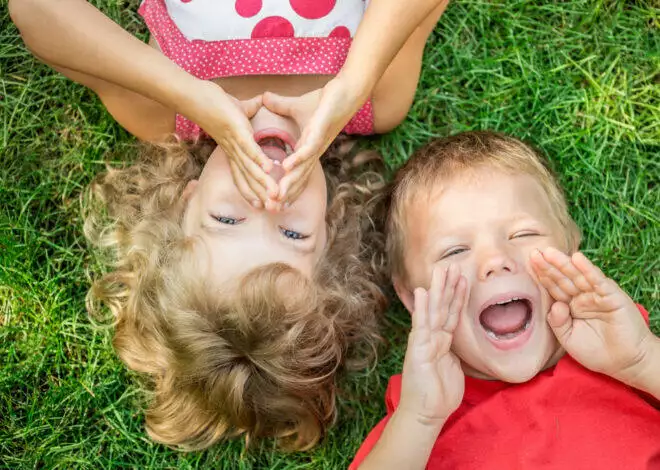When we had our first child, we also were the proud parents of two cats. And neither of those fuzzy boys cared one bit when the baby came home for the first time. Actually, I believe one of them probably hid. But he took refuge under ottomans often, so it really wasn’t a big change. We didn’t have to figure out how to introduce pets and babies
However, other first-time parents are absolutely freaked out about introducing baby to their furry friends, and with good reason. Some pets take a bit of time to grow accustomed to a new family member. Other pets will continue on their merry way, not even acknowledging or caring about the new baby.
A pet is a first child for a lot of couples. Chances are, the pet has his or her routine down to a science…and might even be a teensy bit spoiled. A new baby is going to be like a new sibling and could be seen as competition for attention.
When that pregnancy test turns positive or the ‘Gotcha Day’ becomes finalized, begin to prepare pets for the new arrival that will change the dynamics of the household.
How To Introduce Pets and Babies
Training Lessons
Some pampered pets might have adopted a few bad habits that endear them to the owners. However, if those bad habits translate poorly around a baby, it’s time to begin training sessions to try to modify the behaviors. Scratching for attention, playful biting or jumping can scare or harm an infant. Owners can take on the training at home by using positive reinforcement (like treats or verbal praise) for good behavior and stating “no” in a firm voice when bad behaviors occur. If training at home isn’t effective, enlist a professional to help break hard habits.
Introducing…The Nursery!
A new room for baby is bound to spark fascination and curiosity in pets. Pets will likely sniff out the new room, but don’t let cats take naps in the crib. Cat hair and pet dander may irritate a new baby’s sensitive skin, and animals need to learn that their bed is not with the baby. To detract from animals slumbering in the crib or anywhere else that will be reserved strictly for baby, the Humane Society of the United States recommends using double-sided sticky tape. If you decide that baby’s room is completely off-limits, keep the door closed!
Toys for Baby and Pets
Pets love to play. Cats may find a baby’s toy fun to bat around the house, and puppies or dogs might find plush toys ripe for chewing. Before the baby is born, buy your animal companions new fun toys that will keep them happy and occupied. And make sure to keep baby’s toys separate and placed where pets can’t reach them. Otherwise, your baby might end up with an eyeless teddy bear. In our household, many plush animals have lost their eyes to our puppy.
For ‘Crying’ Out Loud
Babies cry. And scream. A baby’s sounds may frighten an animal. To help your pet adjust to the new baby sounds, the ASPCA recommends playing a recording of a baby cries or screams. If they cower, turn off the sounds. Slowly get them used to the noises your baby will make, so the new noises won’t shock their sensitive hearing.
Introducing the Baby
Before bringing baby home, introduce the baby to the puppy or cat by bringing a blanket that has baby’s scent on it. However, don’t just let the animal sniff it up close. Cesar Milan’s online hub “Cesar’s Way” instructs owners: “Challenge the dog to sniff from a distance, while you are holding the item. By doing so, you are communicating to your dog that the item is yours and then giving permission for the dog to sniff.” If an animal seems distressed when baby comes home, leave the animal alone. Never leave a baby unsupervised near any animal.
Your new baby and the family fur baby will eventually become best friends…and quite possibly partners in crime! While it may take pets a while to adjust, they will soon consider the new baby as part of their pack family. And the baby will grow up knowing the love and companionship of a family pet.





